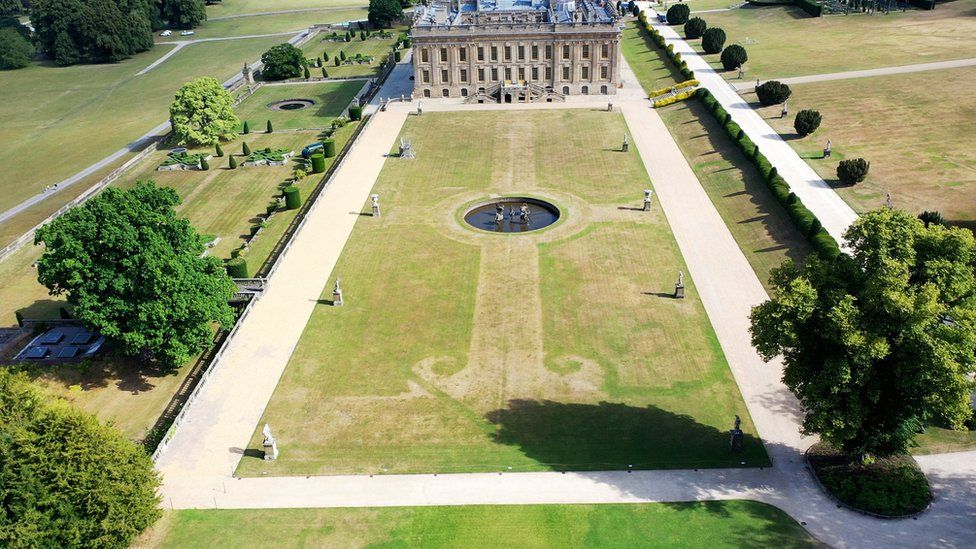Changes in the Landscaping
In 1699 the first Duke of Devonshire commissioned a formal garden for his seat at Chatsworth, including a large expanse called the “great parterre.”
About thirty years later, the third Duke of Devonshire had that area replaced with a more fashionable lawn with simpler pathways at the edges.
This month Europe went through a record-breaking heat wave. Among the effects, the sunlight parched the grass at Chatsworth, particularly the grass planted on the thinner layers of soil where paths once lay. Other parts of the lawn remained greener, having deeper soil to grow in. As a result, the footprint of the great parterre reemerged, as the B.B.C. reports.
Many news outlets running photographs of this landscape stated that it was the first time people could see the outlines of the older design in three hundred years. But the B.B.C. reported that the same thing happened in 2018. That’s what climate change produces: once-rare meteorological events become more common.
Back in 2018 the B.B.C. also reported how the heat had caused the footprint of the eighteenth-century mansion Clumber House in Nottinghamshire to reappear as buried foundation stones caused the ground to scorch.
Clumber House was largely commissioned by the second Duke of Newscastle-under-Lyne in the 1760s, nephew of two prime ministers. This duke was one of the principal patrons of Gen. Henry Clinton during the American War. Late in 1783 he agreed to a request from George III to order the six Members of Parliament under his control to support William Pitt the Younger as prime minister.
Clumber House suffered a series of fires in the late 1800s and early 1900s, and the dukes eventually decided to tear down the mansion and sell the land to pay debts. The mansion footprint is now in a National Trust park, and the dukedom is extinct.
About thirty years later, the third Duke of Devonshire had that area replaced with a more fashionable lawn with simpler pathways at the edges.
This month Europe went through a record-breaking heat wave. Among the effects, the sunlight parched the grass at Chatsworth, particularly the grass planted on the thinner layers of soil where paths once lay. Other parts of the lawn remained greener, having deeper soil to grow in. As a result, the footprint of the great parterre reemerged, as the B.B.C. reports.
Many news outlets running photographs of this landscape stated that it was the first time people could see the outlines of the older design in three hundred years. But the B.B.C. reported that the same thing happened in 2018. That’s what climate change produces: once-rare meteorological events become more common.
Back in 2018 the B.B.C. also reported how the heat had caused the footprint of the eighteenth-century mansion Clumber House in Nottinghamshire to reappear as buried foundation stones caused the ground to scorch.
Clumber House was largely commissioned by the second Duke of Newscastle-under-Lyne in the 1760s, nephew of two prime ministers. This duke was one of the principal patrons of Gen. Henry Clinton during the American War. Late in 1783 he agreed to a request from George III to order the six Members of Parliament under his control to support William Pitt the Younger as prime minister.
Clumber House suffered a series of fires in the late 1800s and early 1900s, and the dukes eventually decided to tear down the mansion and sell the land to pay debts. The mansion footprint is now in a National Trust park, and the dukedom is extinct.


No comments:
Post a Comment